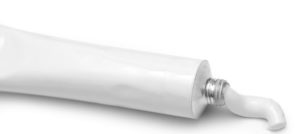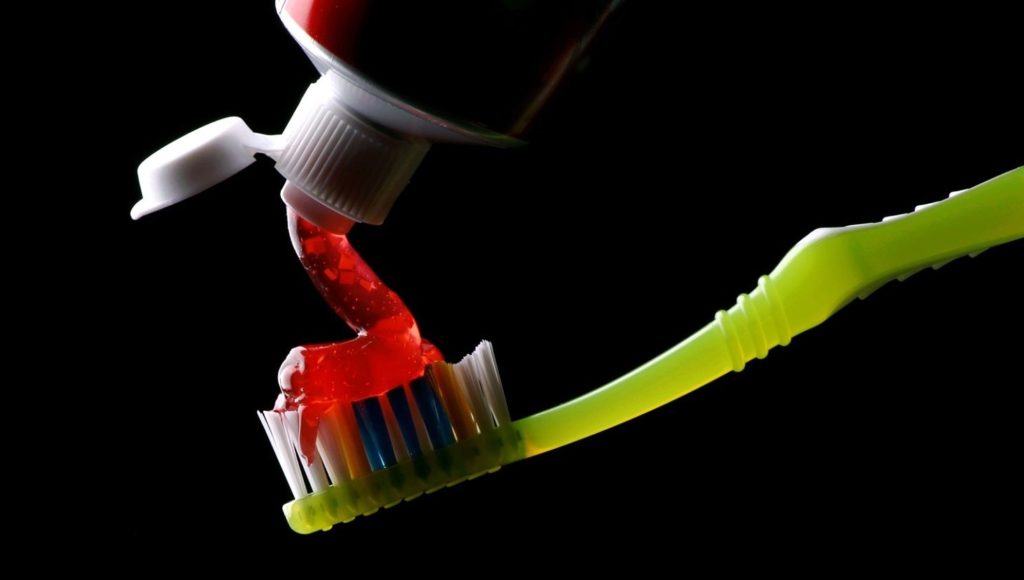
Toothpaste
Considering that toothpaste doesn’t have to be ingested for toxins to enter your system (they can pass through the lining of your mouth directly into your bloodstream) and that the average adult will use about
20 gallons of toothpaste over their lifetime, we always thought that a “no nasty” policy was kind of a no-brainer
However, for some weird reason there are still toothpastes on the market today that contain toxic ingredients. They’ll make all sorts of claims from whitening to strengthening but what they may not tell you is that these ingredients can be seriously unsafe. Some of the major offenders are below, but keep in mind that there are other harmful ingredients that we did not list that could be lurking in your toothpaste. It’s very important to do your research and to know what’s in your toothpaste before you use it.
Fluoride
Everyone has heard of fluoride. In fact, approximately 95% of conventional toothpastes sold in the U.S contain fluoride. In the past, it was drilled into consumers heads that fluoride is a must-have because it can strengthen teeth and make them more resistant to tooth decay. However, in recent years there’s been growing concerns over the health risks that fluoride can present, especially in young children. Ingesting too much fluoride can possibly cause permanent tooth discoloration, stomach problems, skin rashes, and impairment in glucose metabolism. In fact, the FDA requires a warning label on every tube of fluoride toothpaste sold in the US.
Triclosan
In 2016, the FDA banned triclosan from soaps, however it’s still allowed in toothpaste. That’s right. It’s banned from a product that we use on our hands, but not from a product that we put into our mouths. The world is weird. Triclosan, by definition, is a pesticide but it’s been used as an antibacterial agent in toothpastes with the claim that it helps fight plaque and gingivitis. It has even been deemed a “super-chemical” because of its down-right frighteningly strong bacteria fighting ways. Have you everheard of Agent Orange? You know, the herbicide used in the Vietnam War by the U.S military as part of its herbicidal warfare program? Well in a crazy turn of events, it turns out that the chemical structure of triclosan closely resembles a major component in Agent Orange. They’re like compound cousins, if you will. And it’s still allowed in toothpaste. Again, the world is weird. Health concerns associated with triclosan include cancer, weakened heart muscle function, endocrine issues, and bone deformation just to name a few.

So why would the FDA allow such a toxic chemical in toothpaste? Well as it turns out, there’s only one brand on the market that still uses Triclosan and coincidentally it’s the same company that convinced the FDA that the benefits of triclosan far outweigh the risks. In fact, this company actually paid for the toxicology studies that the FDA used to decide if triclosan was safe and effective enough for toothpaste. Sounds legit, right? Now, we’re not going to come right out and say which brand contains triclosan, you can just Google it and see for yourself, but we will say that it starts with a C and rhymes with tollgate. And that’s all we’ve got to say about that.
Saccharin
Saccharin is a petroleum-based sugar substitute. Sounds yummy, right? Lab-produced “sugar” made from crude oil. So tasty. Anyway, we digress. Saccharin is commonly used in diet foods, soft drinks, lip balms, and you guessed it, toothpaste. It’s approximately 350 times sweeter than your run-of-the-mill sugar and falls into the same sweetener category as Acesulfame-K, sucralose, aspartylphenylalaninemethyl ester, alitame and tagatose. Saccharin was linked to cancer in a few clinical studies in the 1970’s but continues to be a commonly used additive in food and hygiene products.
Carrageenan
Derived from seaweed, carrageenan is a common thickening agent in toothpastes – both conventional and natural. It can also be found in foods like chocolate milk, yogurt, and cream. Being used in natural foods and toothpastes (not ours) doesn’t mean carrageenan is totally safe. It has been shown to potentially cause inflammation in the intestine and possible colon tumors.
Aspartame
Aspartame is used as a sugar substitute and is arguably the most common artificial sweetener used today. It’s found in foods, drinks, toothpastes, you name it. The big appeal of aspartame is its use in lowcalorie or diet products. Aspartame is about 200 times sweeter than sugar therefore much less of it can be used to achieve the same level of sweetness, in turn keeping the calories in foods and drinks relatively low. That sounds great, you say? Why did you say “yuck”, you ask? Because aspartame has been known to metabolizes inside your body as both a poisonous wood alcohol and formaldehyde. Yes, formaldehyde. AKA embalming fluid. Possible side effects could include migraines, dizziness, seizures, nausea, numbness, muscle spasms, weight gain, rashes, depression, fatigue, irritability, insomnia, vision problems, hearing loss, heart palpitations, anxiety, vertigo, memory loss, and, brain tumors, birth defects, and joint pain. Aspartame consumption could potentially lead to illnesses such as Alzheimer’s, Diabetes, Multiple Sclerosis, Epilepsy,ParabensLymphoma, Parkinson’s Disease, and Fibromyalgia.
Parabens
Parabens are a fairly common additive in cosmetics, including toothpastes. Used as a preservative, parabens are chemicals that can mimic the hormone estrogen and can potentially cause cancer, developmental, and reproductive issues. Some of the chemicals to watch out for are: Methylparaben, Ethylparaben,Isobutylparaben, Propylparaben,Butylparaben, Isopropylparaben, Benzylparaben. Sodium Lauryl Sulfate & Sodium Laureth Sulfate You know what’s a great idea? Adding a potentially ulcer-causing chemical to your toothpaste to make it foam. Because, as everyone knows, the more foam there is, the cleaner my teeth will be. Sorry to disappoint, but foam doesn’t actually clean your teeth. The need for foam is all in your mind. Sodium Lauryl Sulfate (SLS) and Sodium Laureth Sulfate (SLES) are urfactants that are used in a range of products from industrial cleaners to toothpastes and their main purpose is to provide a foaming lather. The problem with SLS and SLES is that they may cause canker sores, mouth ulcers, stomach issues, and cancer.
Propylene Glycol
Propylene Glycol is a mineral oil that, in the industrial grade, is used in antifreeze, paints, enamels, and airplane de-icers. So just in case your teeth freeze over, propylene glycol’s got you covered. In all seriousness, the pharmaceutical grade would be used in toothpastes to smooth out the texture. Unfortunately, it could also possibly cause cancer, reproductive issues, and skin irritation. We hope we haven’t given you toothpaste induced nightmares, but you can sleep easy knowing that our organic toothpastes are completely free from all chemicals, pesticides, GMOs, glutens, fluoride, saccharin, SLS, SLES, carrageenan, parabens, triclosan, artificial sweeteners or additives, propylene glycol, detergents, or synthetics of any kind.
Testimonial
- Link1
- Link2



